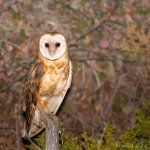marcsantacurz
Well-known member
Maybe this should be posted to the taxonomy group? Anyway, I thought I'd start here.
I was using AllAboutBirds.org to ID the attached photo (Santa Cruz, California, USA, Sept 21, 2018). They classify it as Tyto Alba (https://www.allaboutbirds.org/guide/Barn_Owl/overview). And my National Geographic field guide (7th ed) also shows them as Tyto Alba.
Wikipedia lists it otherwise in the family Tyto (https://en.wikipedia.org/wiki/Tyto) and says (https://en.wikipedia.org/wiki/American_barn_owl) "Based on DNA evidence, König, Weick & Becking (2009) recognised the American Barn Owl (T. furcata) and the Curaçao Barn Owl (T. bargei) as separate species.[1]"
So, what is the correct classification of an American Barn Owl?
[1] König, Claus; Weick, Friedhelm; Becking, Jan-Hendrik (2009). Owls of the World. Bloomsbury Publishing. pp. 46–48. ISBN 978-1-4081-0884-0.
I was using AllAboutBirds.org to ID the attached photo (Santa Cruz, California, USA, Sept 21, 2018). They classify it as Tyto Alba (https://www.allaboutbirds.org/guide/Barn_Owl/overview). And my National Geographic field guide (7th ed) also shows them as Tyto Alba.
Wikipedia lists it otherwise in the family Tyto (https://en.wikipedia.org/wiki/Tyto) and says (https://en.wikipedia.org/wiki/American_barn_owl) "Based on DNA evidence, König, Weick & Becking (2009) recognised the American Barn Owl (T. furcata) and the Curaçao Barn Owl (T. bargei) as separate species.[1]"
So, what is the correct classification of an American Barn Owl?
[1] König, Claus; Weick, Friedhelm; Becking, Jan-Hendrik (2009). Owls of the World. Bloomsbury Publishing. pp. 46–48. ISBN 978-1-4081-0884-0.






